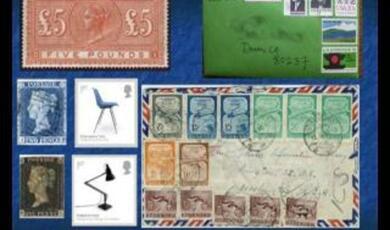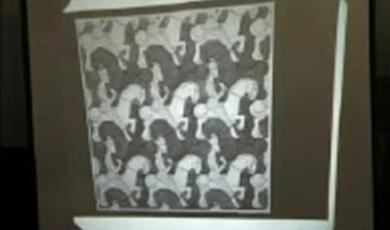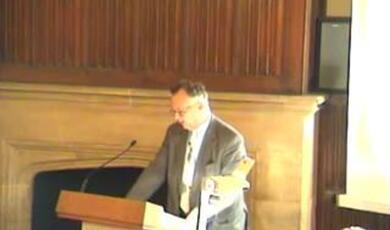The Deceived Brain: Coding and Illusion
Share
- Details
- Text
- Audio
- Downloads
- Extra Reading
We perceive the world through the processing of information given by our senses. Sometimes, this processing is faulty, leading to illusions: shapes or sounds that we perceive differently from their physical reality. These illusions have delighted children and scientists alike for centuries.
This lecture reveals how simple geometric illusions can be modelled mathematically, based on our understanding of how visual signals are coded and decoded by the brain, leading to a better understanding of how we process information.
Download Text
There are mathematical equations in this transcript which does not allow us to embed the text in this page. Please download the file above
There are many books on illusions, from the simple show-and-tell that are often rather dull and repetitive, from the sophisticated neuroscience and art analyses.
- In Trick Eyes: Magical Illusions That Will Activate the Brain (2005), Akiyoshi Kitaoka, the grand master of illusions, presents over 100 of his own optical illusions, including his renowned “Rotating Snakes" and other motion illusions. It serves both as a visual spectacle and a scientific exploration into how our brains interpret visual information
- In Mind Sights: Original Visual Illusions, Ambiguities, and Other Anomalies(1990), Roger Shepard explores the nature of mental imagery, perception, and meaning through a blend of visual illusions, scientific reflection, and philosophical insight. The book is richly illus- trated and presents Shepard’s personal and professional thoughts and drawings on how the mind creates and transforms visual experience
- Perceiving Geometry: Geometrical Illusions Explained by Natural Scene Statistics (2005), by Catherine Q. Howe and Dale Purves. This book explores how the human visual sys- tem interprets geometric illusions by analyzing the statistical relationships between retinal images and their real-world sources. It provides an empirical framework for understand- ing why our perceptions often deviate from physical measurements.
- Vision and Art: The Biology of Seeing (2002), by Harvard neurobiologist Margaret Liv- ingstone is a beautifully illustrated book that explores how our visual system interprets art, revealing how artists have historically manipulated colour, light, and form to evoke emotional responses and convey meaning [12].
- Splendors and Miseries of the Brain: Love, Creativity, and the Quest for Human Happi- ness(2008) by the famous neurobiologist Semir Zeki explores how the brain’s architecture shapes our experiences of love, creativity, and the pursuit of happiness. By examining art, literature, and neuroscience, Zeki offers a personal view into how our neural struc- tures influence our perceptions and emotional lives
References and Further Reading
- Aleksandr Bulatov, Algis Bertulis, Natalja Bulatova, and Yelena Loginovich. Centroid ex- traction and illusions of extent with different contextual flanks. Acta Neurobiologiae Ex- perimentalis, 69(4):504–525, 2009.
- Hermann von Helmholtz, Edmund Atkinson, et al. Popular lectures on scientific subjects. second series. 1881.
- Ewald Hering. Beiträge zur Physiologie. I. Zur Lehre vom Ortssinne der Netzhaut. Engel- mann, Leipzig, 1861.
- Catherine Q. Howe and Dale Purves. Perceiving Geometry: Geometrical Illusions Ex- plained by Natural Scene Statistics. Springer Science & Business Media, New York, NY, 2005.
- David H. Hubel and Torsten N. Wiesel. Receptive fields of single neurones in the cat’s striate cortex. The Journal of Physiology, 148(3):574–591, 1959.
- Wassily Kandinsky. Point and Line to Plane. Solomon R. Guggenheim Foundation, New York, 1947. Translated by Howard Dearstyne and Hilla Rebay. Originally published in 1926.
- Gaetano Kanizsa. Margini quasi-percettivi in campi con stimulazione omogenea. Riv. Psicol., 49:7–30, 1955.
- Gaetano Kanizsa. Quasi-perceptual margins in homogeneously stimulated fields. In
S. Petry and G. E. Meyer, editors, The Perception of Illusory Contours, pages 40–49. Springer, New York, 1987. English translation of Kanizsa (1955).
- Akiyoshi Kitaoka. Trick Eyes: Magical Illusions That Will Activate the Brain. Barnes & Noble, New York, 2005.
- Paul Klee. The Thinking Eye: The Notebooks of Paul Klee, Volume I. Lund Humphries, London, 1961.
- Kurt Koffka. Principles of Gestalt Psychology. Harcourt, Brace and Company, New York, 1935.
- Margaret S. Livingstone. Vision and Art: The Biology of Seeing. Harry N. Abrams, New York, 2002.
- Franz Carl Müller-Lyer. Optische urteilstäuschungen. Archiv für Anatomie und Physiolo- gie, Physiologische Abteilung, Supplement:263–270, 1889.
- David Mumford. Elastica and computer vision. Algebraic Geometry and Its Applications, pages 491–506, 1992.
- Surajit Nundy, Beau Lotto, David Coppola, Amita Shimpi, and Dale Purves. Why are angles misperceived? Proceedings of the National Academy of Sciences, 97(10):5592– 5597, 2000.
- Johann Joseph Oppel. Uber geometrisch-optische tauschungen. Jahresbericht des physikalischen Vereins zu Frankfurt am Main, (37–47), 1855.
- William D. Orbison. Shape as a function of the vector field. The American Journal of Psychology, 52(1):31–45, 1939.
- Johann Christian Poggendorff. Zusatz des herausgebers. Annalen der Physik und Chemie, 186(7):500–525, 1860. Published as an editorial note in response to Zöllner’s submission.
- Friedrich Schumann. Beiträge zur analyse der gesichtswahrnehmungen. erste abhand- lung: Einige beobachtungen über die zusammenfassung von gesichtseindrücken zu ein- heiten. Zeitschrift für Psychologie und Physiologie der Sinnesorgane, 23:1–32, 1900.
- Arthur G. Shapiro and Dejan Todorovic´, editors. The Oxford Compendium of Visual Illu- sions. Oxford University Press, New York, 2017.
- Roger N Shepard. Mind Sights: Original visual Illusions, Ambiguities, and other Anoma- lies, with a Commentary on the play of mind in Perception and art. WH Freeman/Times Books/Henry Holt & Co, 1990.
- David R. Topper. The poggendorff illusion in descent from the cross by rubens. Percep- tion, 13(6):655–658, 1984.
- Wilhelm Wundt. Die geometrisch-optischen täuschungen. Abhandlungen der Mathematisch-Physischen Classe der Königlich Sächsischen Gesellschaft der Wis- senschaften, 24:55–178, 1898.
- Semir Zeki. Splendors and Miseries of the Brain: Love, Creativity, and the Quest for Human Happiness. Wiley-Blackwell, Chichester, UK, 2008.
- Johann Karl Friedrich Zöllner. Ueber eine neue art von pseudoskopie und ihre beziehun- gen zu den von plateau und oppel beschriebenen bewegungsphänomenen. Annalen der Physik, 186(7):500–525, 1860.
©Professor Alain Goriely 2025
This event was on Tue, 17 Jun 2025
Support Gresham
Gresham College has offered an outstanding education to the public free of charge for over 400 years. Today, Gresham College plays an important role in fostering a love of learning and a greater understanding of ourselves and the world around us. Your donation will help to widen our reach and to broaden our audience, allowing more people to benefit from a high-quality education from some of the brightest minds.


 Login
Login







